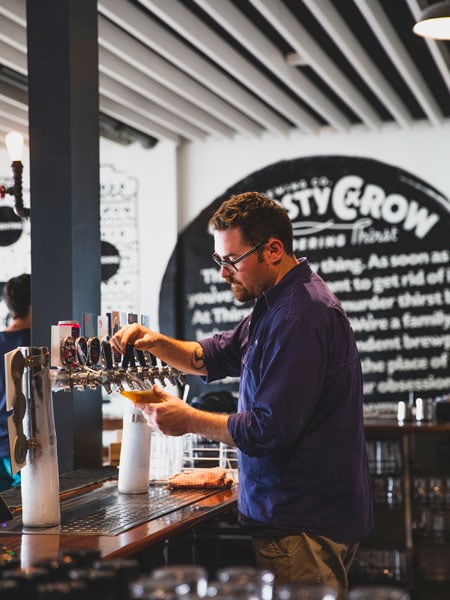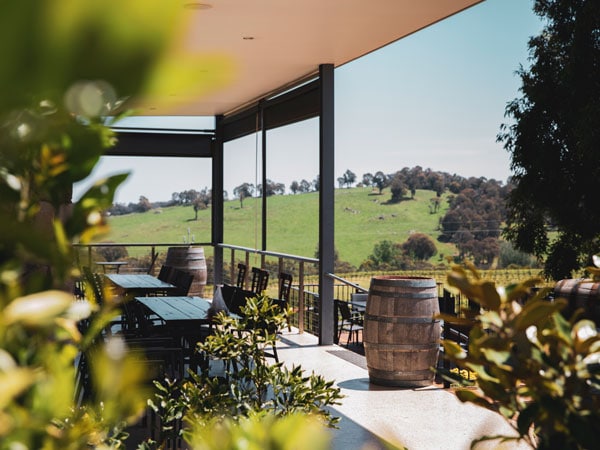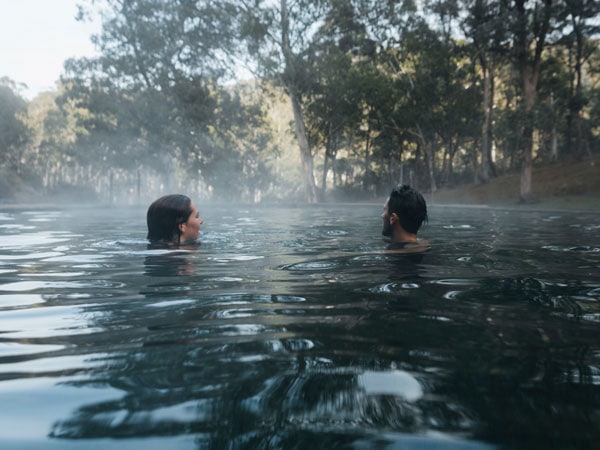March 25, 2021
![]() 14 mins Read
14 mins Read
The Riverina to Snowy Valleys Way is one of NSW’s iconic road trips, traversing west to east from the rich agricultural lands of Griffith to the alpine valleys of the Snowy Mountains’ western foothills. Reflecting the diverse food-producing landscapes of NSW and the sheer ingenuity involved in cultivating them, this is a journey that celebrates the land, makers, history and heritage. And, through a wealth of unique food and drink experiences, engineering marvels and architectural gems, it’s all ripe for discovery.
Watch the video below for a taste of what awaits you along the Riverina to Snowy Valleys Way…
Your journey begins in one of NSW’s most unique cities and its culinary offering sets the tone nicely. With its distinctive radial pattern and wide tree-lined streets echoing the nation’s capital, Griffith was designed in the early 20th century by Walter Burley Griffin as part of the Murrumbidgee Irrigation Scheme. This engineering feat helped transform the flat plains and red earth of the Riverina region into Australia’s food bowl, and today it grows everything from wine grapes, citrus and rice through to nuts, vegetables, cotton and cereal grains.

The Riverina region into Australia’s food bowl. (Image: DNSW)
The many Italian migrants who settled in Griffith after the First and Second World Wars have helped add another layer of interest, building as they have a distinctive food and wine culture that’s one of the city’s main drawcards.

Limone Dining uses fresh produce sourced daily from nearby Piccolo Farm. (Image: DNSW)
Start sampling as you mean to go on over breakfast at Limone Dining, where the finely crafted dishes – served in a rusted interior of recycled materials – speak to this heritage using fresh produce sourced daily from nearby Piccolo Farm, the head chef’s family farm, before taking a self-guided winery tour.

The Riverina is the largest wine-producing region in NSW. (Image: DNSW)
The Riverina – with Griffith at its heart – is the largest wine-producing region in NSW, its Mediterranean-like climate conducive to producing shiraz, cabernet sauvignon, chardonnay and – the star of the show – a luscious botrytis semillon dessert wine.

Enjoy a charcuterie board and matching wines at Yarran Wines. (Image: DNSW)
Get acquainted with the local offering at Calabria Family Wines, with its Tuscan-style cellar door, De Bortoli Wines’ original cellar door at Bilbul, and small boutique winery Yarran Wines.
Continue your quest in Leeton, 45 minutes’ drive south-east of Griffith along the Irrigation Way. Cellar doors to add to your itinerary include Toorak Wines and Lillypilly Estate Winery. But for something a little different take a detour to Whitton Malt House. Opened in 2020 and overlooking Lake Hulong, it sits alongside a working malt house and brings together – under one architecturally designed roof – the various products that distillers, brewers and bakers create from its malt. Book in for lunch at its restaurant, where inventive dishes include a starter of house-made pretzel made with malted flour topped with Murray River salt and a side of beer cheese – and maybe even check in for an overnight stay. Whitton Malt House’s one- and two-bedroom lakeside villas are slick, modern and cute-as-a-button.
The town of Leeton itself is another Griffin design that formed part of the irrigation scheme and is famed for its Art Deco buildings. Catch a movie or request a tour at the iconic Roxy Theatre, which has been operating as a cinema since 1930. Art Deco aficionados should time their visit for the Leeton Art Deco Festival, which takes place annually in July, or spend the night at the Historic Hydro Motor Inn.

Catch a movie or request a tour at the iconic Roxy Theatre. (Image: DNSW)
To stretch your legs and soak in some nature, drive a few minutes north of town to discover one of Australia’s special Ramsar sites: endangered waterbirds and waders call the Fivebough and Tuckerbil Wetlands home, and visitors here can partake in a spot of birdwatching from viewing shelters or walk the atmospheric woodland and wetland tracks.
Meet the Murrumbidgee River at Narrandera, 30 kilometres further south-east via Yanco and its heritage-listed weir. With its historic buildings, old iron-lattice railway bridge and cedar-lined streets, Narrandera is a pretty town with plenty to explore. Make sure you enjoy brunch (and a browse) at The Red Door Cafe and Juadine Interiors in town.

There is plenty to explore in Narrandera. (Image: DNSW)

Shop and dine at The Red Door Cafe and Juadine Interiors. (Image: DNSW)
The outdoorsy route will see you swimming and picnicking on one of three natural beaches on the Murrumbidgee or at Lake Talbot and its nearby water park. Here, in the shady embrace of river red gums, you’ll also find the Narrandera Nature Reserve, known locally as Koala Reserve for the 200 koalas that live and hang out here – sometimes literally, on branches overhanging the river. Make the most of this tranquil spot by overnighting at Lake Talbot Tourist Park, which offers camp spots and cabins as well as kayak hire. Water skiing at Lake Talbot is also a popular activity.
Before you leave town, don’t forget to check out the Water Tower Mural, which forms part of the 500-kilometre Riverina Outdoor Art Trail (which also includes Gundagai’s famous Dog On The Tuckerbox) and depicts the town’s most famous furry residents.

Don’t forget to check out the famous Water Tower Mural.
Drive 60 kilometres east out of Narrandera along the evocatively named Canola Way to reach Coolamon. Steeped in country charm and character, Coolamon has much to recommend it: an interesting firefighting history, a heritage streetscape of cafes, boutiques and classic pubs with wide verandahs, and even a museum featuring agricultural machinery tucked within the historic Up-To-Date Store Cultural Precinct – itself a turn-of-the-century department store and trip back in time.

Coolamon is steeped in country charm and character. (Image: DNSW)
But for some people, it’s all about the cheese. Head to Coolamon Cheese Co.’s renovated 1920s co-op building on main street Cowabbie to witness the production of its handcrafted cheeses – including a range of lactose-free cheeses – made from local Riverina milk. Then proceed to sample them on-site at The Bread and Cheese Synergy Cafe Restaurant.
Hop back in the car to join the self-drive Canola Trail touring route towards Junee, 30 minutes east, which takes you through a landscape of canola fields that comes alive in spring in a dazzling blaze of yellow for as far as the eye can see.

Take the self-drive Canola Trail touring route towards Junee from Coolamon. (Image: DNSW)
From cheese to chocolate, it’s time to explore Junee. Located in the town’s old flour mill, the Junee Licorice and Chocolate Factory is an icon; take a guided tour to see how its sweet treats are made and stop for hot chocolate made with melted organic Belgium-styled couverture chocolate at its on-site Millroom Restaurant.

Take a tour and stock up on chocolate in the gift store at the Junee Licorice & Chocolate Factory. (Image: DNSW)
Then take another guided tour – this time at the Junee Roadhouse Railway Museum, the location of the last steam train depot in NSW and also home to the impressive feat of engineering that was the largest turntable in the southern hemisphere when it opened in the 1940s; today it is one of the few working roundhouses left in the world.
Head due south for about half an hour to Wagga Wagga. Set in the heart of the Riverina on the banks of the Murrumbidgee, Wagga Wagga is NSW’s largest inland city and it wears these credentials well: boasting a vibrant hospitality scene (don’t miss independent brewpub Thirsty Crow for craft beer and cider, regional wine and local artisan food or Uneke Lounge, a funky cafe and boutique) and a first-rate regional gallery that holds the National Art Glass Collection.

Stop by independent brewpub Thirsty Crow for craft beer and cider, regional wine and local artisan food. (Image: DNSW)

Don’t miss out on a meal at Uneke Lounge. (Image: DNSW)
Surprisingly, Wagga Wagga also lays claim to Australia’s ninth best beach – according to the 2020 best beaches list compiled by Tourism Australia’s beach ambassador Brad Farmer. Wagga Wagga is a stretch of golden sand flanked by a tree-dappled bank that runs along the lazy Murrumbidgee for the recreation of locals and visitors alike, who can be found walking, picnicking, barbecuing, kayaking and splashing around in the water.
The walking track that runs along the river here forms part of the Wiradjuri Trail, a 42-kilometre loop around the city that links significant Aboriginal places across river banks, hilltops and more. Join proud Wiradjuri man Mark Saddler of Bundyi Cultural Tours to learn more about the city and region from a traditional perspective including insight into the Wiradjuri language and local bush tucker.

Learn about the region from proud Wiradjuri man Mark Saddler of Bundyi Cultural Tours. (Image: DNSW)
Consider staying the night in or around town before switching up the scenery: on a quiet residential street close to Wagga’s cafes and restaurants, The Houston is a 10-suite boutique hotel set in an elegant 19th-century house, while Belisi Farmstay Cottage – 15 minutes’ drive north-east of town – offers country luxury in swish recycled shipping containers looking back over Wagga, the stunning Riverina countryside and the mountains beyond.

Watch the sunset from the outdoor seating or sit around the firepit at Belisi Farmstay.
On your way out of town towards Tumut, 25 kilometres east of Wagga, drop into the cellar door at Borambola Wines for a tasting of its estate-grown wines, beer and cider, a platter of local produce, and a tale or two: Borambola Homestead has a storied history that includes royalty and bushrangers which owner-operator Tim McMullen is more than happy to share.

The beautiful homestead at the Borambola Wines vineyard.
Leaving the Riverina behind for the Snowy Valleys, you’ll find Tumut in the undulating foothills of the Snowy Mountains.

Find Tumut in the undulating foothills of the Snowy Mountains.(Image: DNSW)
Before you hit town, stop at Adelong Falls Gold Mill Ruins to wander through this extraordinary gold mining works, where the stone remains of the heritage-listed Reefer Battery, once capable of crushing 24 to 30 tonnes of gold ore a day, are visible besides the tumbling waters of Adelong Creek, which also serves as a blissful swimming hole on warm days. Explore the natural beauty of the site and learn about both the Aboriginal history and mining history of the area via interpretative signage at its viewing platform.
Tumut itself is a picturesque riverside town that serves as the ideal base for exploring the wide open spaces and gastronomic offerings of the region. Have breakfast at The Coffee Pedaler before meandering along the peaceful Tumut River Walk, taking in the Tumut Wetlands that teem with birdlife and the contemplative Labyrinth for Peace located in Pioneer Park.
Spend some time on a Wiradjuri Aboriginal Cultural Tour to appreciate further the beauty of the region from an Indigenous perspective; this hands-on experience offers up ancient landscapes – once the meeting place for Aboriginal tribes including the Wiradjuri, Ngungawal and Wolgalu – and the opportunity to make your traditional crafts including bush rope and jewellery.

Join a Wiradjuri Aboriginal Cultural Tour to appreciate further the beauty of the region from an Indigenous perspective. (Image: DNSW)
Next up on the agenda is lunch at micro-brewery Tumut River Brewing Co., which serves gourmet pizzas and craft beer in a funky-feeling converted tyre shop. For small-batch gin and liqueurs infused with Australian native flavours head to Pretty Parrot Distilling, with its tasting room set in the back of the historic Oriental Hotel.

Stop for a cold one and lunch at micro-brewery Tumut River Brewing Co. (Image: DNSW)
And for a truly special experience, settle in for the night at Nimbo Fork Lodge, 20 minutes’ drive north of town, which offers raw natural beauty and a collection of luxury suites and cottages at the fork of Tumut River and Nimbo Creek. The latest addition to this former fishing lodge comes courtesy of Three Blue Ducks, the Sydney-based purveyors of authentic and ethical dining experiences. The focus at the new Nimbo restaurant is on exquisite dishes that heroes produce from the Snowy Valleys such as the fresh local trout, and nettles and herbs foraged straight from the property’s own riverbank.

Settle in for the night at Nimbo Fork Lodge. (Image: DNSW)

Delicious food and wine us all part of the experience at Nimbo Fork. (Image: DNSW)
Head south from Tumut to Tumbarumba via the rolling hills and apple orchards of Batlow and stop en route for cider at rustic, family-run cellar doors. As well as a tasting, at Wilgro Orchards you can treat yourself to a Devonshire tea or pick up fresh fruit, apple cider vinegar and freshly baked apple pie to takeaway. At nearby Crafty Cider you’ll also meet the motley crew of animals, camels included, that live within the property’s SMART Animal Sanctuary.
Tumbarumba itself is a vibrant small town with a crisp mountain climate idyllically set against a backdrop of peaks, bushland, vineyards, pastures and pristine streams.
Truly get amongst it by swapping four wheels for two and cycling the newly completed Tumbarumba to Rosewood Rail Trail, the first rail trail in NSW on government-owned land, which runs for 21 kilometres through the countryside and farmland along the region’s original railway line. Heritage-listed Wolter Cottages at the start of the route and interpretative signage at old stations along the way clue you on to the line’s fascinating history. Hire an e-bike from Tumba Bikes and Blooms for some extra horse power.
Alternatively, walk a 12-kilometre stretch of the Hume and Hovell Track from Henry Angel Trackhead campground to Tumbarumba Creek.

Dine at Courabyra Wines, one of the region’s original vineyards.
For lunch with a view visit Courabyra Wines, one of the original vineyards in this cool-climate wine region where you can sample white wines and sparkling as crisp, green and fresh as the landscape around you. Or give the designated driver a day off by booking a tour with Tumbarumba Touring Company, which customises small-group tours taking in the region’s vineyards for cellar door openings and wine tastings with a smattering of local food and produce.
And make sure to visit newly opened boutique Forage, located in a converted weatherboard church, as well as Nest Cinema Cafe Books: a real hidden gem of the region that operates as a boutique cinema, artfully curated bookstore and cafe serving a creative menu of seasonal dishes and Friday night pizzas.
Kip for the night in a comfortable cabin at nearby Tumbarumba Caravan Park.
Heading back towards Sydney, make one final detour to explore the wonders of the Yarrangobilly area of Kosciuszko National Park. Book a guided tour of one of the Yarrangobilly Caves from the Yarrangobilly Caves Visitor Centre, which are on offer three or four times a day.

Explore the wonders of the Yarrangobilly Caves. (Image: DNSW)
Jillabenan Cave is the smallest and most accessible, and it’s also the oldest, at about two million years young, making it richly decorated with astonishing formations – before descending into one of Kosciuszko’s deep valleys for a dip in the Yarrangobilly Thermal Pool. Surrounded by nature while soaking in the 27˚C mineral waters is the ideal way to wind down after such an extraordinary adventure.
Make sure you stay up to date with the road conditions before you set off with the latest travel alerts at Visit NSW.

Swim in the thermal pools in Yarrongobilly. (Image: DNSW)
Download our beautifully-illustrated map of NSW’s best road trips (pictured below) or find the giant wall map inside issue 90 of Australian Traveller magazine.

Illustration: Mike Rossi
For the  best travel inspiration delivered straight to your door.
best travel inspiration delivered straight to your door.
very nice